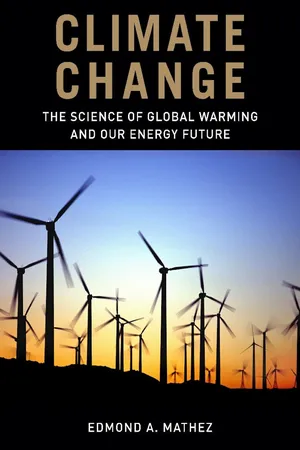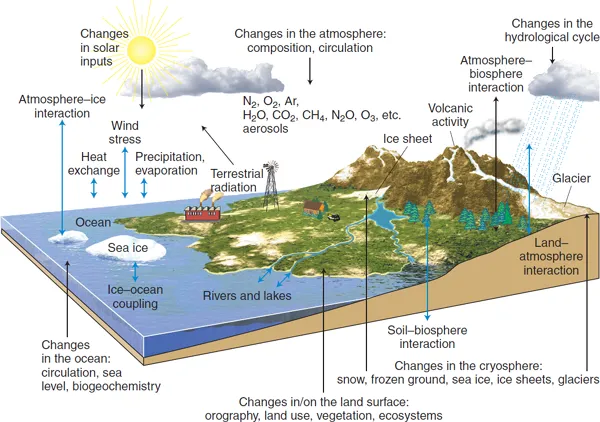![]()
“RAIN, HEAVY AT TIMES, will begin in late morning and continue into the evening hours as a cold front sweeps across the area….” Ah, the weather forecast—what would we do without it? There is no shortage of conversation about the weather, which, after all, touches our daily lives. For some, the weather is pretty important—especially if their harvest depends on it. For others, it is more tangential. I’m thinking of myself here—most days I just want to know about my trek in and out of New York City, where I work. Will rain or snow make it impossible or just more miserable than usual? And climate? What would a climate forecast be like? “The next decade will bring persistent showers and mild temperatures in January to March, and extensive periods of no rainfall at all throughout the summer months.” Hmm… that seems a bit remote from my immediate worry of getting to work.
Weather and Climate
The musings here illustrate the essential difference between weather and climate, the topic of this book. It also illustrates one of the conundrums in reducing carbon dioxide (CO2) emissions from the use of fossil fuels, the main culprit in global warming. Weather refers to conditions in the atmosphere at any one time. The now familiar radar images on television show that local weather systems develop and dissipate rapidly over the course of hours to a day. On a continentwide scale, weather systems form and decay over days to perhaps a week. A persistent weather system, such as a warm spell, may last for a couple weeks, especially in midlatitudes where the tracks of the systems are commonly determined by the position of the polar jet stream, as chapter 2 explains.
Climate, in contrast, can be thought of as the “average weather” for a particular region over some time. Region here can mean the entire globe, as in global warming; it can mean a large land area, say, eastern North America; or it can even mean a small one, as in the “microclimate” of a wine-producing valley near Bordeaux, France. Over all these scales, however, climate implicitly refers to the long term. One conundrum, therefore, is that it is difficult to marshal either the individual or the collective will to make the changes necessary to avoid negative impacts of global warming because they generally do not affect our immediate lives.
Although we have become adept at forecasting weather over hours to days, predictions beyond that become progressively more uncertain with distance into the future. Weather is inherently chaotic. Strictly speaking, the term chaotic means that small differences in initial conditions result in large differences in how a system will eventually develop. In other words, to predict weather accurately, one would have to know the temperature, humidity, barometric pressure, wind velocity, precipitation, and other characteristics of a weather system everywhere across an affected region; the more information at hand, the farther out in time a reliable forecast becomes possible.
Being an average condition, climate is more stable and displays distinctive patterns of change on distinctive timescales. Examples include annual changes such as monsoons, which are shifts in winds that bring seasonal rains to a number of regions in the tropics and subtropics. They also include fluctuations that occur only every several years, the most notable of which is El Niño, referring to the periodic warming of the equatorial eastern Pacific Ocean that commonly influences climate across much of the globe.
The Climate System
Climate is a dynamic system resulting from the combined interactions of various parts of Earth with one another and with the Sun. The parts are the atmosphere; the ocean (the hydrosphere); glaciers, terrestrial ice sheets, and sea ice (collectively known as the cryosphere); the living biomass (the biosphere); and even the solid Earth (the lithosphere) (figure 1.1). Think of it as your body, with all of its parts interacting in a pulsating whole. And like your body, the climate system is not just a set of physicals interactions. It is also a dynamic chemical system, with matter flowing through its various parts.
The atmosphere, being the medium that we live in, is the part of the climate system that affects us most directly. It plays a major role in transporting heat around the planet. Because Earth is a sphere, the Sun’s heat is more intense near the equator than near the poles. This uneven distribution generates winds that carry heat from the equator to the poles and from the surface to the upper atmosphere. The atmosphere is not isolated from the ocean, however. The ocean circulates, in part driven by the winds and guided by the positions of continents, and thereby also transports heat toward the poles. Indeed, the ocean holds far more heat than the atmosphere, but it flows much more slowly.
FIGURE 1.1
The dynamic climate system
The diagram shows the climate system’s various components and indicates the chemical and physical interactions among them (double arrows) and the various processes acting on them (single arrows). N2 = nitrogen; O2 = oxygen; Ar = argon; CH4 = methane; N2O = nitrous oxide; O3 = ozone; orography refers to the mountain landscape.
As for the chemical interactions, the most important are the exchanges of carbon among the atmosphere, ocean, and biosphere (here we can also include the dead biomass held mainly in soils). In fact, we can think of each of these spheres as reservoirs where nearly all the carbon on or near Earth’s surface is stored. This description leads to the concept of the carbon cycle, referring to the flow of carbon among the various reservoirs. In time periods of months to decades, photosynthesis by plants and decay of organic materials affect the amount of CO2 in the atmosphere, but over longer times it is the ocean that exerts the dominant control on atmospheric CO2 content because the amount of carbon in the ocean is more than 50 times that in the atmosphere (or in the entire living biomass). If we think of the climate system as something like our body, the atmosphere and ocean are its main organs, and the carbon cycle is the circulation system that connects them and other organs. Because these elements are so central, they serve as the focus of the first several chapters of this book.
Most of the carbon (more than 99.9 percent) on Earth exists not in the ocean, atmosphere, or biosphere (the “surface” reservoirs), but in a deep reservoir in the form of rocks—that is, the lithosphere. The lithosphere is part of the climate system mainly because carbon flows between it and the surface carbon reservoirs, but this flow is far slower than the flow of carbon among the surface reservoirs. Over millions of years, a close balance has apparently persisted between the amounts of carbon flowing from the surface to the rock reservoirs via removal of CO2 from the atmosphere and ocean by the formation of carbonate- and other carbon-bearing rocks and the return of CO2 to the atmosphere by the breakdown of those rocks at the high temperatures and pressures of the deep Earth. In fact, this long-term balance appears to have acted as a natural, planetary thermostat, maintaining conditions on Earth’s surface that are conducive to the evolution and survival of life since nearly the beginning.
The different parts of the climate system also interact through feedbacks, or phenomena that amplify or diminish the forces that act to change climate. An example helps to envision them. As the Arctic warms due to buildup of greenhouse gases, sea ice melts. As sea ice melts, there is less bright ice to reflect solar energy back to space, so more energy is absorbed by the dark ocean. The greater absorption of energy in turn further warms the ocean and overlying atmosphere and causes even more ice to melt. In this way, greenhouse-gas warming is amplified. This feedback in part accounts for why the Arctic is generally more sensitive to global warming than is the rest of the planet. Feedbacks can be complex and operate in unpredictable ways, and they are one reason that projecting future climate is fraught with uncertainty.
The climate system is complicated in other ways, one of which is that the various climate phenomena operate on different timescales (table 1.1). Some of these phenomena and their associated timescales are familiar—for example, the daily variations of warm days and cool nights, and the annual passage of the seasons. Other phenomena occur on longer or irregular intervals, and still others occur at timescales beyond the human experience and are consequently difficult to imagine. Our knowledge of the latter may also be incomplete because the evidence for them is buried (commonly and literally) in the geological record.
Climate Change: Separating Facts from Fears
What we do know from the available records, both geological and observational, is that the climate is changing. Hardly a day goes by without some mention of it in the news. Earth’s climate is warming; CO2 and other greenhouse gases have been building up in the atmosphere mainly as a consequence of the burning of fossil fuel; and the scientific evidence is now overwhelming that this buildup is causing the warming. These statements are the facts of climate change.
| TABLE 1.1 DIFFERENT TIMESCALES OF WEATHER AND CLIMATE PHENOMENA |
| Timescale | Phenomena |
|
| Daily | Warm days and cool nights due to solar heating and Earth’s rotation |
| 3–7 Days | Weather events, such as passage of fronts |
| Months | Eastward-propagating weather disturbances across the tropical Indian and Pacific oceans |
| Yearly | Warm summers, cool winters, and shifts in zones of precipitation due to tilt of Earth’s spin axis and its orbit around the Sun
Monsoons, notably in the Indian subcontinent, where the cause is summer heating of landmasses that draws moist winds off oceans |
| 23–36 Months | Periodic wind and temperature oscillations in the equatorial stratosphere due to internal atmosphere dynamics |
| 2–7 Years | El Niño events, in which changes in equatorial Pacific Ocean currents and winds result in dramatic shifts in rainfall in equatorial regions globally and in lesser shifts in the climate of some temperate regions |
| 1–3 Decades | Generally ill-defined oscillations, such as the North Atlantic Oscillation (NAO), an oscillation in atmospheric pressure that influences the positions of storm tracks across the ocean and affects the climates of western Europe, the Mediterranean basin, and eastern North America |
| Centuries | Irregular fluctuations that have led to multicentury cold or warm periods, such as the Medieval Warm Period and the Little Ice Age, the causes of which are uncertain but may be related to one or more natural phenomena, such as variations in solar irradiance |
| 10,000–100,000 Years | Regular variations in orbital parameters (the slow oscillations in Earth’s tilt relative to the orbital plane, precession, and eccentricity of its orbit around the Sun) affecting the amount of energy reaching the Northern Hemisphere. Responsible for the approximately 100,000-year glacial cycles of the past million years |
| Millions of Years | Changes in the positions of continents, solar luminosity, and composition of the atmosphere, all of which affect climate globally |
Source: J. R. Christy, D. J. Seidel, and S. C. Sherwood, “What Kinds of Atmospheric Temperature Variations Can the Current Observing Systems Detect and What Are Their Strengths and Limitations, Both Spatially and Temporally?” in Temperature Trends in the Lower Atmosphere: Steps for Understanding and Reconciling Differences, edited by T. R. Karl, S. J. Hassol, C. D. Miller, and W. L. Murray (Washington, D.C.: Climate Change Science Program, Subcommittee on Global Change Research, 2006), 29–46. |
Less certain are how much the climate will warm in response to growing emissions and to what extent the warming will change the world around us. Should the wa...

